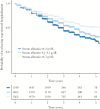Serum Albumin as a Prognostic Marker for Serious Non-AIDS Endpoints in the Strategic Timing of Antiretroviral Treatment (START) Study
- PMID: 29244111
- PMCID: PMC5853310
- DOI: 10.1093/infdis/jix350
Serum Albumin as a Prognostic Marker for Serious Non-AIDS Endpoints in the Strategic Timing of Antiretroviral Treatment (START) Study
Abstract
Background: Serum albumin may be used to stratify human immunodeficiency virus (HIV)-infected persons with high CD4 count according to their risk of serious non-AIDS endpoints.
Methods: Cox proportional hazards models were used to analyze the risk of serious non-AIDS events in the Strategic Timing of Antiretroviral Treatment (START) study (NCT00867048) with serum albumin as a fixed and time-updated predictor. Models with exclusion of events during initial follow-up years were built to assess the ability of serum albumin to predict beyond shorter periods of time. Secondarily, we considered hospitalizations and AIDS events.
Results: Among 4576 participants, 71 developed a serious non-AIDS event, 788 were hospitalized, and 63 experienced an AIDS event. After adjusting for a range of variables associated with hypoalbuminemia, higher baseline serum albumin (per 1 g/dL) was associated with a decreased risk of serious non-AIDS events (hazard ratio, 0.37 [95% confidence interval, .20-.71]; P = .002). Similar results were obtained in a time-updated model, after controlling for interleukin 6, and after excluding initial follow-up years. Serum albumin was independently associated with hospitalization but not with risk of AIDS.
Conclusions: A low serum albumin level is a predictor for short- and long-term serious non-AIDS events, and may be a useful marker of risk of noncommunicable diseases, particularly in resource-limited settings.
Keywords: HIV; albumin; biomarker; non-AIDS comorbidity; non-communicable disease.
© The Author 2017. Published by Oxford University Press for the Infectious Diseases Society of America. All rights reserved. For permissions, e-mail: journals.permissions@oup.com.
Figures


Comment in
-
All About the Albumin? Prognostic Capacity of Serum Albumin in Patients With Treated HIV Infection.J Infect Dis. 2018 Jan 17;217(3):347-349. doi: 10.1093/infdis/jix463. J Infect Dis. 2018. PMID: 29244120 Free PMC article. No abstract available.
References
Publication types
MeSH terms
Substances
Associated data
Grants and funding
LinkOut - more resources
Full Text Sources
Other Literature Sources
Medical
Research Materials

